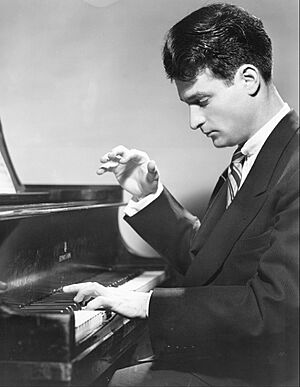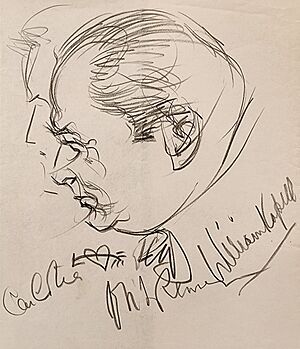William Kapell facts for kids
William Kapell (born September 20, 1922 – died October 29, 1953) was a very talented American pianist. Many people thought he was one of the best pianists from the United States. Sadly, he died at age 31 in a plane crash in 1953. He was flying home from a concert tour in Australia when the accident happened.
Contents
The Life of William Kapell
Early Life and Music Start
William Kapell was born in New York City on September 20, 1922. He grew up in a neighborhood called Yorkville, Manhattan. His parents owned a bookstore there. His father had Spanish-Russian Jewish roots, and his mother was from Poland.
William started learning piano at the Third Street Music School Settlement. His teacher was Dorothea Anderson La Follette. She taught him several times a week. Later, he studied at the Juilliard School with Olga Samaroff. She was a famous piano teacher and the former wife of conductor Leopold Stokowski.
Winning Competitions and Becoming Famous
William won his first music competition when he was just ten years old. His prize was a special dinner with the famous pianist José Iturbi. In 1941, he won two more big awards: the Philadelphia Orchestra's youth competition and the Naumburg Award.
The next year, when he was 19, the Walter W. Naumburg Foundation helped him perform his first big concert in New York. This concert won him the Town Hall Award for the best concert by a musician under 30 that year. Soon after, he signed a special contract to record music with RCA Victor.
Rising to Stardom
Kapell became very famous in his early twenties. This was partly because of his amazing performances of Aram Khachaturian's Piano Concerto in D-flat. His recording of this piece in 1946 was a huge success. He played it with Serge Koussevitzky and the Boston Symphony Orchestra.
People started calling him "Khachaturian Kapell" because he was so good at playing that piece. Besides his exciting piano skills, William Kapell was also popular because of his good looks and his mop of black hair.
Touring the World
By the late 1940s, Kapell had toured many places. He played concerts in the United States, Canada, Europe, and Australia. Everyone loved his performances. Many people thought he was the most brilliant and daring young American pianist of his time.
On May 18, 1948, he married Rebecca Anna Lou Melson. They had two children together. Anna Lou was also a talented pianist. She had studied with Sergei Tarnowsky, who also taught the famous pianist Vladimir Horowitz.
A Deep and Versatile Musician
At first, some people thought Kapell only played very difficult pieces. But he was a deep and flexible musician. He played many different types of music, from J. S. Bach to Aaron Copland. Copland admired Kapell's playing so much that he was writing a new piece just for him when Kapell died.
Kapell practiced piano for up to eight hours every day. He kept track of his practice time in a notebook. He also made time to work with other musicians he admired. These included Artur Schnabel, Pablo Casals, and Rudolf Serkin. He even tried to get lessons from Arthur Rubinstein and Vladimir Horowitz, but they felt they had nothing more to teach him. Horowitz later said that Kapell was already too good to be taught by him.
From August to October 1953, Kapell went on a tour in Australia. He played 37 concerts in just 14 weeks. He performed in many cities, including Sydney, Brisbane, Melbourne, and Geelong.
Tragic End
William Kapell played his last concert in Geelong, Australia, on October 22, 1953. In this concert, he played Chopin's famous "Funeral March" Sonata. A few days later, he started his flight back to the United States. He told reporters at the airport that he would not return to Australia because some critics there had been harsh.
He was on BCPA Flight 304. On the morning of October 29, 1953, the plane was flying in fog. It hit treetops and crashed on Kings Mountain, near the San Francisco airport. Everyone on board died. His friend, the broadcaster Alistair Cooke, talked about Kapell's death on his radio show. Kapell's funeral was held in New York on November 2, and he was buried at Mount Ararat Cemetery.
Kapell's Lasting Impact
Remembering a Great Talent
After Kapell's death, the famous musician Isaac Stern created the William Kapell Memorial Fund. This fund helped talented musicians from other countries come to the United States to gain more experience. The Australian violinist Ernest Llewellyn was the first person to receive this help in 1955.
Many pianists have continued to be fascinated by Kapell's playing over the years. Musicians like Eugene Istomin, Gary Graffman, Leon Fleisher, and Van Cliburn have all said that Kapell influenced them. Leon Fleisher even called Kapell "the greatest piano talent this country has ever produced."
Kapell's wife, Anna Lou Dehavenon, worked to keep her late husband's recordings available to the public. She also became an expert on homelessness in New York. She said her own experience of suddenly becoming a single mother with no income helped her understand the struggles of others.
The Kapell Piano Competition
In 1986, a piano competition at the University of Maryland was renamed the William Kapell International Piano Competition. This was done to honor him. Since 1998, it has been held every four years at the university's Clarice Smith Performing Arts Center.
Kapell's Recordings
In 1944, Kapell signed a special contract with RCA Red Seal to record his music. Many of his early recordings were released on 78RPM records. Later, some came out on LPs. However, by 1960, all of Kapell's official recordings were no longer being sold.
In 1962, RCA Victor re-released Kapell's recording of the Khachaturian Piano Concerto. Later, in 1970, his recordings of Beethoven's Piano Concerto No. 2 and Prokofiev's Piano Concerto No. 3 were also re-released. For many years, fans shared unofficial copies of his recordings.
In the 1980s, RCA Victor started releasing Kapell's music on compact discs (CDs). These included the Khachaturian and Prokofiev concertos, and a CD with only Chopin's music.
In 1998, RCA Victor released a large 9-CD set. This set included all of Kapell's official recordings. It had Chopin's mazurkas and sonatas, and concertos by Rachmaninoff, Prokofiev, and Khachaturian. It also had less known pieces, like Shostakovich preludes, Scarlatti sonatas, and the Copland Piano Sonata. This set sold very well and helped new listeners discover Kapell's music.
Some other recordings from live performances have also been released. In 2004, several recordings from Kapell's last Australian tour were given to his family. RCA Victor released these in 2008 as Kapell Rediscovered. This set included music that had not been heard before, like Debussy's Suite bergamasque and Chopin's Barcarolle. In 2013, RCA released an even bigger 11-CD set with all of Kapell's complete recordings, including those from his final Australian tour.



